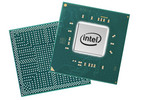
Acer Chromebook Spin 511 R752T in review - The 2-in-1 laptop for the classroom
Intel Celeron N4120 | Intel UHD Graphics 600 | 11.60" | 1.2 kg

The Intel Celeron N4120 is a quad-core SoC primarily for inexpensive notebooks and was announced late 2019. It runs at 1.1-2.6 GHz (Single Core Burst) and is based on the Gemini Lake platform. Compared to the predecessor, the Celeron N4100, the refresh offers a 200 MHz higher Boost clock. Similar to the Apollo Lake predecessors, the chip is manufactured in a 14 nm process with FinFETs but offers slightly improved processor cores, double the amount of L2 cache, a smaller package, a new generation of monitor outputs (Gen 10) and a partly integrated WiFi chip. Besides four CPU cores, the chip also includes a DirectX 12 capable GPU as well as a DDR4/LPDDR4 memory controller (dual-channel, up to 2400 MHz). The SoC is not replaceable as it is directly soldered to the mainboard.
Architecture
The processor architecture ist still called Goldmont Plus. Compared to the older Goldmont cores in Apollo Lake, they feature an increased level 2 cache (to 4 MB). That means the per-clock-performance should be a bit better, but not near the Core CPUs like Kaby Lake Y.
Performance
The average N4120 in our database is not much faster than AMD's Zen-based, affordable Athlon Silver 3050e, as far as multi-thread benchmark scores are concerned, with the Intel Celeron 6305 and the Core i5-7Y54 found close nearby as well. It's a very basic CPU that we're talking about here. While it does have four cores, these are some seriously slow cores, dashing hopes of anybody looking to get a Core i3-like performance for cheap.
GPU Performance
The UHD Graphics 600 (Gemini Lake) is based on Intel's Gen9 architecture, which supports DirectX 12 and is also used for the Kaby Lake / Skylake / Apollo Lake graphics adapters (like HD Graphics 520). Equipped with 12 EUs and a clock of up to 700 MHz, the performance should be roughly on par with the older HD Graphics 500 (Apollo Lake).
The chip also includes an advanced video engine with hardware support for the playback of VP9 and H.265 material (8-bit color-depth).
Power Consumption
Just like most other N-class Intel processors, Celeron N4120 has a default TDP of 6 W (also known as PL1), making it a good option for passively cooled laptops, tablets, mini-PCs. It's manufactured on a very old (as of late 2022) 14 nm process, though, making for poor energy efficiency.
| Codename | Gemini Lake Refresh | ||||||||||||||||||||||||
| Series | Intel Gemini Lake | ||||||||||||||||||||||||
Series: Gemini Lake Gemini Lake Refresh
| |||||||||||||||||||||||||
| Clock Rate | 1100 - 2600 MHz | ||||||||||||||||||||||||
| Level 2 Cache | 4 MB | ||||||||||||||||||||||||
| Number of Cores / Threads | 4 / 4 | ||||||||||||||||||||||||
| Power Consumption (TDP = Thermal Design Power) | 6 Watt | ||||||||||||||||||||||||
| Manufacturing Technology | 14 nm | ||||||||||||||||||||||||
| Max. Temperature | 105 °C | ||||||||||||||||||||||||
| Socket | BGA1090 | ||||||||||||||||||||||||
| Features | DDR4-2400/LPDDR4-2400 RAM, PCIe 2, MMX, SSE, SSE2, SSE3, SSSE3, SSE4.1, SSE4.2, VMX, SMEP, SMAP, MPX, EIST, TM1, TM2, Turbo, AES-NI, RDRAND, RDSEED, SHA, SGX | ||||||||||||||||||||||||
| GPU | Intel UHD Graphics 600 (200 - 700 MHz) | ||||||||||||||||||||||||
| 64 Bit | 64 Bit support | ||||||||||||||||||||||||
| Architecture | x86 | ||||||||||||||||||||||||
| Announcement Date | 11/04/2019 | ||||||||||||||||||||||||
| Product Link (external) | ark.intel.com | ||||||||||||||||||||||||




HP Stream 11-ak0013ns: Intel UHD Graphics 600, 11.60", 1.1 kg
External Review » HP Stream 11-ak0013ns
HP Stream 14s-dq0024ns: Intel UHD Graphics 600, 14.00", 1.5 kg
External Review » HP Stream 14s-dq0024ns
Acer Chromebook 315 CB315-3H-C6UR: Intel UHD Graphics 600, 15.60", 1.6 kg
External Review » Acer Chromebook 315 CB315-3H-C6UR
Acer Travelmate B3 TMB311-31-C369: Intel UHD Graphics 600, 11.60", 1.4 kg
External Review » Acer Travelmate B3 TMB311-31-C369
Microsoft Surface Laptop SE, Celeron N4120: Intel UHD Graphics 600, 11.60", 1.1 kg
External Review » Microsoft Surface Laptop SE, Celeron N4120
Alldocube iWork 20 Pro: Intel UHD Graphics 600, 10.50", 0.6 kg
External Review » Alldocube iWork 20 Pro
Acer TravelMate B3 TMB311-31-C1VR: Intel UHD Graphics 600, 11.60", 1.4 kg
External Review » Acer TravelMate B3 TMB311-31-C1VR
Acer Chromebook Spin 311 CP311-2H-C95K: Intel UHD Graphics 600, 11.60", 1.2 kg
External Review » Acer Chromebook Spin 311 CP311-2H-C95K
Lenovo 300e G2-81M9006EGE: Intel UHD Graphics 600, 11.60", 1.2 kg
External Review » Lenovo 300e G2-81M9006EGE
Chuwi LarkBook CWI509: Intel UHD Graphics 600, 13.30", 1.1 kg
External Review » Chuwi LarkBook CWI509
Chuwi Hi10 XR: Intel UHD Graphics 600, 10.10", 0.6 kg
External Review » Chuwi Hi10 XR
» Mobile CPU Comparison
Comparison of all mobile CPU series
» Mobile Processors - Benchmarklist
Benchmarklist of all known CPUs that are used in laptops (desktop and laptop CPUs)
Top 10 Laptops
Multimedia, Budget Multimedia, Gaming, Budget Gaming, Lightweight Gaming, Business, Budget Office, Workstation, Subnotebooks, Ultrabooks, Chromebooks
under 300 USD/Euros, under 500 USD/Euros, 1,000 USD/Euros, for University Students, Best Displays
Top 10 Smartphones
Smartphones, Phablets, ≤6-inch, Camera Smartphones